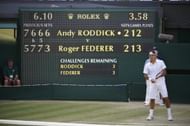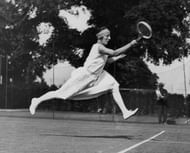There is something very magical about Wimbledon. Something that makes even the non-believers, believers. With a rich history of 127 years and the honour of having produced legends of tennis, it lends itself to being called the most prestigious tennis tournament in the world. Played at the All England Lawn Tennis Club, Wimbledon is the third Grand Slam of the year, and the only one to be played on grass.
Gleaming with British aristocracy and a royal air that is seldom seen in today’s sporting events, Wimbledon remains one of those few tournaments that have managed to embrace modernity without losing out on the traditions. (They introduced a retractable roof on centre court in 2009 owing to disruptions due to rain and are planning to build another one over Court no.1; yet, they insist on all participating players to dress in white).
There are so many iconic moments, iconic landmarks that spring to my mind when I think of Wimbledon. Growing up, Wimbledon was perhaps the only tournament that I could watch on television and be it the scoreboard on Centre Court or the frenzied cheering of fans on Henman Hill/Murrah Mound, those images were the ones that stayed with me till the next Wimbledon came along.
There is a reason why every up and coming tennis player dreams of winning the Wimbledon – not the US Open, Australian Open or even Roland Garros, but Wimbledon. Lifting the coveted Venus Rosewater Dish for women or the silver Gentleman’s singles trophy for the men, remains that defining moment in any player’s career. So much so that 8-time French Open Champion, Rafael Nadal, also fondly called the ‘King of Clay’, remarked how much he wanted to win the championship on grass.
But trophies, prize money and aspirations apart, Wimbledon has given to tennis some of its most memorable moments. Perhaps it is because of the immense media attention it garners around the world that the players who play on its hallowed courts etch their name in greatness, albeit in a small part, but a piece of history belongs to them.
Wimbledon’s evolving fashion has always been a talking point. From the conservative long skirts and full length trousers in the 20s and 30s, to ultra glam dresses and customized jackets today, Wimbledon has seen it all. Yet, what has remained consistent is the flutter of the white clothes in the English breeze against the beautiful green lawns of the courts.
Many players have tried to defy this age-old tradition, notably, tennis legend Andre Agassi who did not play at Wimbledon in the early stages of his career because he did not want to conform to what he then called the “stuffy” atmosphere of Wimbledon. He of course won the singles championship in 1994, wearing pristine white clothes! But, then what is tennis without the idiosyncrasies of the players.
So, be it Suzanne Lenglen who started wearing fashionable clothes and makeup on court in the 20s, or Sharapova’s tuxedo inspired wear, the women of Wimbledon have given the photographers plenty. But, the men are not too far to be left behind. Bjorn Borg and John Mcenroe brought the bratty spirit to Wimbledon with their cycle shorts and fiery red bandanas in the 70s, which did not exactly scream fashion but was a photo-op moment nonetheless. Roger Federer, always the picture of elegance, rolled back the years when he strolled onto the courts of Wimbledon in 2009, wearing a jacket and trousers.
But tennis still remains the focal point at Wimbledon. The locals take the sport very seriously and despite not seeing many Brits win the honour in the recent past (the last time a Brit lifted either of the trophies was in 1977 when Virgina Wade won the women’s singles), there is an unbridled passion among the spectators. Taking in the rain while enjoying their strawberries and cream, the crowd at Wimbledon is diverse. Be it the royal box which hosts the Dukes and Duchesses and on rare occasions the Queen herself, or movie stars and singers, Wimbledon has a pull with the celebrities with perhaps US Open at Flushing Meadows, New York its only competitor in attracting the glitterati. The moment below encapsulates the quirky spirit of Wimbledon
However, it’s the character shown by great tennis players such as Bjorn Borg, Pete Samras, Roger Federer, John Mcenroe, Steffi Graff, Chris Evert, Martina Navratilova, Ivan Lendl, Stefan Edberg, Venus and Serena Williams that defines why Wimbledon is so revered. These players and many other unsung heroes have given their sweat, blood and much more to the matches in an attempt to reach the next step in a journey to crowning glory.
Perhaps the most inspiring story of them all is that of one Croat – Goran Ivanisevic, who became the first wildcard in the history of Wimbledon to win the tournament. After having lost three Wimbledon finals earlier, he had slipped in the rankings and came into the tournament as an overwhelming underdog in 2001. But such is human spirit that he went through the tournament in his characteristic charming fashion and won over several fans. When he finally won the championship, defeating Pat Rafter in 5 closely fought sets, he fell to his knees in utter disbelief and relief. After all, he had achieved what is every tennis player’s dream!
Wimbledon has seen many glorious rivalries – Borg and Mcenroe, Becker and Lendl, Federer and Nadal, Federer and Roddick, Chris Evert and Navratilova, Steffi Graff and Monical Seles and of course the William sisters. The American sister duo literally dominated the tournament in the late 90s and 2000s. Venus, the older of the two has won 5 singles titles, same as her younger sibling Serena who might go on to add more to that tally. What makes their story so interesting is the fact that not only did they face off against each other at Wimbledon, they also went on to play the doubles and win it comprehensively; a story indeed for the ages! And if you ever wondered who started the tradition of running into the players’ box after a victory, look no further.
Be it stamping your name in the tennis world like a young Roger Federer did when he defeated Pete Sampras in 2001, or redeeming yourself like Jana Novotna, who won the Wimbledon in 1998 after a tearful choke in 1993, Wimbledon has seen it all. From perhaps the greatest match ever played [Roger Federer vs Rafael Nadal Wimbledon 2008 final] to literally the longest match ever played [John Isner vs Nicolas Mahut's marathon 3 day slug fest at Wimbledon 2010]; from individual heartbreak experienced by the likes of Andy Roddick and Ivan Lendl, to a nation’s collective grief on seeing Tim Henman lose; Wimbledon reminds us all about the beauty of tennis and the humanness of the people who play it.
This would not be a post about Wimbledon’s greatness however, if I do not mention Sue Barker – the broadcast Queen of Wimbledon. A far cry from the over-the-top and intrusive interviewers of today, her on-court interactions with the players, especially after the finals, make for great viewing. Who can forget Andy Murray‘s emotional breakdown after the 2012 final, something which Sue Barker handled beautifully.
Another iconic moment remains the Duke of Kent walking past the line of ball boys and girls after the finals, occasionally chatting them up and lending the royal aura to the event.
There is just so much history associated with Wimbledon; great matches, great atmosphere, great champions have been witnessed here. As a tennis fan I cannot think of a tournament that embraces the spirit of sportsmanship better than Wimbledon and the very fact that it has endured its allure over a century stands as testimony to its greatness. Here is where magic happens!
Who Are Roger Federer's Kids? Know All About Federer's Twins



